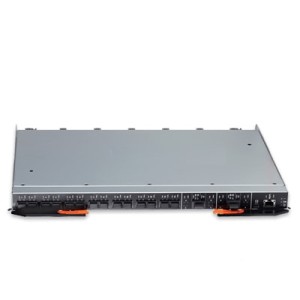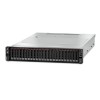Lenovo Flex System Fabric SI4093 System Interconnect Module
Simple Management
The Lenovo® Flex System™ Fabric SI4093 System Interconnect Module enables a simplified integration of the
Flex System into your existing networking infrastructure. The default configuration of the SI4093 requires no management for most data center environments, eliminating the need to configure each device or individual ports, thus reducing the number of management points. The device provides a low latency, loop-free interface that does not rely upon spanning tree protocols, thereby removing one of the greatest deployment and management complexities of a traditional switch.
Flex System Fabric SI4093 System Interconnect Module
Offers easy connectivity and reduced management and setup time. Flexible port mapping enables dynamic configuration of active ports. Conforms to industry standards. Interoperates with existing networks. Uses a pre-configured loop-free interface that does not rely upon spanning tree protocols.
Simple Yet Powerful
- Increased performance
- Pay-as-you-grow investment protection and lower total cost of ownership
- Cloud ready optimized network virtualization with virtual NICs
- Cloud ready VM-aware networking
- Simplified network infrastructure
- Transparent networking
- Advanced network management
Easily Connect
The SI4093 is a low-touch, simple-to-use device that provides a transparent network interface connecting the upstream networking infrastructure to the Flex System chassis compute and storage nodes. In addition to simplifying interoperability, the SI4093 provides a clear division of roles and responsibilities between network and system administrators. Clients can realize savings up to 60%1 in cabling and upstream switching CAPEX costs and significant power reduction OPEX costs when comparing the SI4093 to the architecture associated with a traditional pass-thru device. This also increases return on investment by reducing the qualification cycle and increasing the speed of deployment while providing investment protection for scaling I/O bandwidth requirements into the future.
Flexibility and Scalability
The SI4093 provides extreme scalability which can help reduce cost and complexity and enable rapid deployment today or in the future. Flex System pay-as-you-grow scalability allows clients to easily and cost- effectively activate additional ports through the purchase of a simple software license key. Additionally, the new flexible port mapping feature offers unmatched configuration customization by allowing any active port on the SI4093 to be designated as either an internal or external port. This port mobility capability enables I/O
Connectivity optimization within the Flex System chassis. With this capability, a client can deploy a pair of SI4093 modules to support an application requiring six 10 Gb node ports. Supporting this application would require
some vendors to deploy up to 6 Ethernet modules. Consequently, this provides clients with up to
66%2 fewer devices to manage, thereby lowering acquisition and operational costs, plus reducing power requirements.
Increase Performance
With the growth of virtualization and the evolution of cloud, many of today’s applications require
low latency, security, and high-bandwidth performance. The SI4093 supports sub-microsecond
latency, a fraction of some competitors, allowing end users to quickly access their data and make critical business decisions faster while assisting them in gaining a competitive edge. In addition to supporting 10 Gb ports, the SI4093 also can support 40 Gb external uplink ports thereby enabling forward-thinking
clients to connect to their advanced 40 Gb network or as investment protection for the future. This helps reduce cable complexity while providing 4 times larger external uplink bandwidth. Each SI4093 module delivers full line-rate performance of up to 1.28 TBps throughput, up to 3 times more throughput than other vendors.4 The SI4093 also offers increased security and performance advantage when configured in VLAN-aware mode, by not forcing communications upstream into the network, adding latency and creating more network traffic.
Tech Specs
Interfaces:
- Flexible port mapping provides users the ability to assign ports based on their needs.
- Each internal 10 Gb port or external 10 Gb SFP+ port counts as a single 10 Gb port license. It is possible to exchange any combination of four 10 Gb internal and/or 10 Gb external port licenses into a single external 40 Gb QSFP+ port license.
- A single external 40 Gb QSFP+ port license can also be broken out into four 10 Gb port licenses.
- 40 Gb ports can only be used as external ports.
- Upgrades must be done in order.
Base Module: (PN 00FM518)
- 14 x 10 Gb internal and 10 x 10 Gb external uplinks
- With flexible port mapping, clients have 24 port licenses that can be applied to the internal and external ports.
Upgrade 1 License (Requires base module) (PN 95Y3318)
- Enables additional 14 x 10 Gb internal and 2 x 40 Gb external uplinks
- With flexible port mapping, client enables an additional 22 port licenses (total of 46 with the base) that can be applied to the internal and external ports.
Update 2 License (Requires base module and upgrade 1) (PN 95Y3320)
- Enables all ports 42* x 10 Gb internal and 14 x 10 Gb plus two x 40 Gb external uplinks
Performance:
- 100% line rate performance
- Less than 1 microsecond latency
- 1.28 TBps non-blocking throughput (full duplex)
- 960 MBps
Power Consumption: Typical power consumption of 95 W
Warranty: Takes on the warranty of the chassis (next business day replacement with phone support and software upgrades).
Environmental Specifications:
Heat Dissipation: 1127 BTU/hour (typical)
Mean Time Between Failures (MTBF)†: 236,805 hours @ 40°C
1 Based on full chassis, redundant connectivity and list price of SI4093, EN4091, SFP+ SR transceivers on the module and the upstream switch plus average cost per port of a Cisco Nexus 5548. Minimum of 2 per SI4093 and upstream Cisco, plus 28 on EN4091 and upstream Cisco.
2 Clients wanting 6 ports of 10 Gb Ethernet simply need two SI4093 interconnect modules with flexible port mapping, while with HP, clients will require six HP Virtual Connect FlexFabric 10 Gb/10D Modules.
3 Manage one Lenovo Networking G8264CS top-of-rack switch versus 20 devices (two G8264CS switches and 18 SI4093 modules)
4 Based on spec sheet for SI4093 (1.2 TBps) vs. HP Virtual Connect (480 GBps )
http://h18004.www1.hp.com/products/quickspecs/13127_div/13127_div.pdf
* Requires adapter able to support 6 ports like CN4058 or use all SI4093 ports.
† MTBF is calculated using the Telcordia Technologies Reliability Prediction Procedure for Electronic Equipment, (SR-332 issue 2) Parts Count (method 1 case 1) failure rate data.


